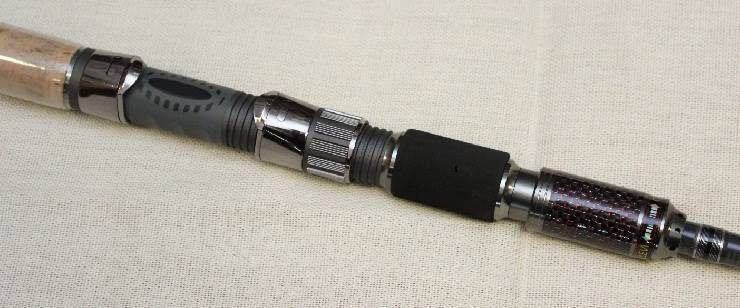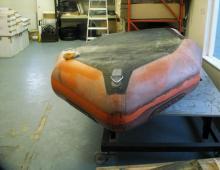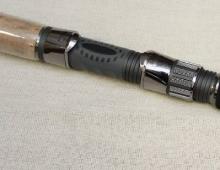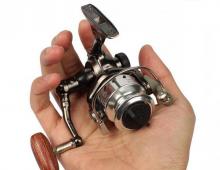How to choose feeder rods?
The range of feeder rods is quite large, and it is difficult for a beginner to understand the various models. And if the seller does not understand what he is selling and tries to sell the product at a higher price, then it turns out to be a complete mess.
And instead of the pleasure of buying, you experience frustration from wasted money and time. After all, different feeder models are designed for particular fishing conditions.
So how to understand the intricacies of choosing a feeder rod and what you need to pay attention to before buying? Feeder (in translation means to feed) - designed to catch fish that is at the bottom of the reservoir.
Feeder gear differs from bottom gear in that it allows you to feed the fishing area with a diameter of no more than three meters at a distance of up to one hundred meters from the coast.
Such accuracy is achieved by a short training and the right choice of feeder rod.
The choice of feeder rod, first of all, depends on the reservoir where you will fish. Feeder gear is quite versatile, it allows you to catch in a powerful current, and in a fast wind, and at fairly large depths.
Experienced anglers have more than one feeder rod in their arsenal, because weather conditions can change dramatically during the day.
In addition, if you are an avid fisherman and spend all your free time fishing, then you should go broke and buy expensive professional tackle.
And if you go fishing infrequently, then there is no point in an expensive rod, you can buy good quality tackle and gradually, if desired, assemble a set of feeder rods.
Optimum feeder rod length
Casting distance depends on the length of the rod. The most common rods are from 3 meters to 4 meters long. With such a rod it is easy to cast tackle over a distance of more than 50-70 meters.
On small reservoirs, the casting distance will range from 20 to 40 meters. Enough rods with a length of 2.5 to 3.5 meters.
In addition, the small length of the rod is convenient if there is a lot of coastal, high vegetation around you.
In thickets of reeds or coastal shrubs, it will simply be impossible to cast with a five-meter rod without catching on the vegetation.
In stores there are feeder rods with varying lengths.
For example, a 3.5 meter rod is made, with the help of an additional knee, 4.5 meter, but the price of such feeder rods is quite high.
If you are going to buy a feeder for the first time, then stop at a length of 3.5 to 4 meters.
Rod test
A rod test is a weight range that indicates what weight of bait it is designed for. For example, you came to a pond without a current and a 40 gram feeder. To the weight of the feeder add approximately 10-25 grams per bait weight.
So, you need a rod designed for 65 grams. The blank of the rod must have a marking indicating the weight of the load in grams or ounces. But some manufacturers simply label rods by class.
Let's take a look at them to understand:
- The Ultra Light Feeder is a rod up to 3 meters long and with a weight range from 10 to 40 grams. Designed for bodies of water without current. Casting distance from 15 to 25 meters. It is convenient to use in places where there is a lot of coastal vegetation, trees. It is also convenient to fish from a boat. The maximum weight of the fish is up to one kilogram.
- Light Feeder is a rod with a length of 3 to 3.5 meters and a weight range of 40 to 60 grams. It is designed for a reservoir with stagnant water or a weak current. Casting distance from 40 to 45 meters. Used to find feeding places for fish. With such a rod, it is easy to move along the shore of the reservoir in search of fish. The maximum weight of the fish is up to three kilograms.
- The Medium Feeder is a rod with a length of 3.4 to 3.9 meters and a weight range of 60 to 100 grams. It can be used both for reservoirs with current, and for reservoirs with stagnant water. It is considered a universal rod. It is used in the most various places and conditions of catching. Allows the use of feeders of different weights. The rod is quite strong, which allows you to catch large fish weighing up to five or even seven kilograms.
- Medium Heavy Feeder - rod length from 3.6 to 4 meters, with a weight range from 80 to 110 grams. Used for rivers with an average flow when casting from 30 to 40 meters. This rod is used for big fish.
- Heavy Feeder - rod length from 4 to 4.6 meters, with a weight range from 100 to 120 grams. The rod is used for fishing on rivers with different currents, from slow to strong. Excellent strength allows you to make casts up to 60-70 meters and compete with river monsters weighing from ten kilograms.
- Extra Heavy Feeder - rod length from 4.2 to 5.5 meters, with a weight range of 120 grams and above. It is used for ultra-long casts up to 100, and sometimes more than meters and fishing in the strongest current. It has super strength and has proven itself for catching fish from fifteen kilograms and above.
It is also undesirable to use the maximum test, this will lead to rapid wear and possible breakage of the rod.
The optimal condition, for example, if you have a feeder with dough up to 100 grams, you need to use equipment in the amount of 80-85 grams.
Rod action
Action or flex is the ability of a rod to bend under load. The rod is divided into three types according to the system: fast, medium and slow.
How to catch more fish?
I have been active fishing for quite some time and have found many ways to improve the bite. And here are the most effective ones:- . Attracts fish in cold and warm water with the help of pheromones included in the composition and stimulates their appetite. It's a pity that Rosprirodnadzor wants to ban its sale.
- More sensitive gear. About reviews and instructions for other types of gear you can find on the pages of my site.
- Lures using pheromones.
In a fast action rod, only the upper part bends, and a slow action rod bends along its entire length:
- Slow action (slow) - the rod bends along the entire length to the handle. It is intended for catching, medium-sized fish in small reservoirs, rivers. The maximum distance cast is about 30 meters. Allows the use of thin fishing lines and "invisible" equipment, smoothes out fish jerks.
- Average action (averase) - the rod bends to the middle from the top. Has average characteristics. Definitely suitable for beginner anglers. Allows you to cast up to 50 meters. They show themselves perfectly in the middle course.
- Fast action is a strong rod in which only the tip bends. With this rod you can cast to a point with a diameter of about 3 meters. They can carry out a quick fishing fish. However, there are small disadvantages, the rod, sometimes, is not able to extinguish the jerk of a large caught fish, which leads to a break in the leash.
If you are new to feeder fishing, you should first choose a fast action rod. With such a rod, you will not be afraid of breakage and will be able to make long casts.
What material is the best feeder rod?
For the production of feeder rods, the following materials are used: fiberglass, carbon fiber, composite:
- Fiberglass is a material that can withstand extreme conditions and is also inexpensive. High strength, wear resistance, not afraid of hitting the side of the boat or concrete parapet - this is a small part of the advantages of fiberglass. However, there is a significant disadvantage - this is the weight of the rod. And since feeder fishing is quite dynamic, the weight of the rod plays a big role.
- Composite - an "alloy" of carbon fiber and fiberglass. Pretty light feeder rods with good strength. Deservedly enjoys great popularity in sport fishing. Sturdy enough, unpretentious in handling. The price is slightly more expensive than fiberglass rods.
- Carbon fiber (high modulus graphite) is an almost weightless strong rod. If you buy a feeder with a length of 4.5 meters or more, then a carbon fiber rod is what you need.
However, this type of rods has a significant disadvantage - withstanding huge loads when fishing, a carbon fiber rod can easily break when it hits the side of a boat or a tree.
Even a small amount of sand that gets into the joint of the knees can destroy it over time. And in terms of cost, carbon fiber takes first place. The price of a carbon fiber rod starts at $100.
"telescope" or "plug"
Feeder rods are both plug-in and telescopic. Which one to choose is up to you. Some people like the compact dimensions of the “telescope”, while others like to take their time assembling plug connections.
When choosing, it should be remembered that in the "telescope", due to the design, there are few throughput rings. And at least 10 rings are considered optimal. There are no problems with rings in the plug. There are many of them and they distribute the load over the entire length of the rod.
Feeder rod guides
When purchasing a feeder, take a closer look at the throughput rings. Many do not do this and in vain. After a certain period of time, the fishing line begins to break, the casts become not so distant and absolutely inaccurate.
And many begin to sin on a low-quality manufacturer. But experienced fishermen immediately understand what is happening just by glancing at the access rings. The fact is that poor quality access rings are quickly rubbed with fishing line.
Therefore, the requirements for the quality of the material of the through-rings should be the highest. Although, to be completely honest, any rings wear out over time, but this time can last more than one hundred fishing trips.
You should also pay attention to the fastening of the rings. It is better if it is from three legs, and not from two. Rings from manufacturers such as Fuji, Balzer, with inserts made of titanium, silicon, and porcelain have proven themselves to be excellent.
What you need to know about feeder tips when buying?
Almost always, together with the feeder, in a set, two, three, or even four tops are sold. Tips, like the rods themselves, vary in flexibility and test. They are painted in three colors: red, green, yellow.

The red tip is the stiffest, the yellow tip is medium flexible, the green tip is the most flexible.
You should know what they are made of, since different materials have different sensitivities, which affects bites.
During the cast, the tip is not involved in the process. The rod takes all the load.
It probably goes without saying that a green tip will show bites better, but in strong winds or strong currents, the angler will not be able to understand whether it is bites or weather conditions.
Conversely, a stiff tip may give little indication of bites in calm weather. The tops of feeder rods are quite fragile and if handled carelessly, you risk breaking them.
But don't get upset. Tips can be purchased separately from the feeder in the store. When buying, ask if there are tips for your feeder on sale.
It often happens that the tip test does not match the rod test. Check that the feeder and rod match.
Which brand to choose and at what price do they sell?
Mikado is rightfully considered the best manufacturer of feeder rods.
Excellent combination of price and quality:
- Silver EagleTele Picker- length from 3 to 3.5 meters and dough from 20 to 60 grams at a price of only 1000 rubles.
- Salmo Diamond Tele Feeder- 3.3 meters long and with a test weight of up to 120 grams, the cost of such a rod is 1600 rubles.
- Banax Mega Tele Feeder - 3.6 meters long and with dough up to 90 grams, cost - 4300 rubles.
- Daiwa Triforce Tele Feeder- 3.6 meters long and with dough up to 60 grams, cost - 2000 rubles.
- Shimano - one of the most common brands that has earned high praise among anglers. 50% of anglers use rods of this brand.
- Shimano Vengeance Tele Feeder Heavy- 3.9 meters long and with dough up to 110 grams, cost - 5500 rubles.
- Shimano Aernos Tele Feeder- length from 3.6 to 4 meters with dough from 60 to 90 grams, cost - 6300 rubles.
And a couple more tips on choosing a feeder rod:
- Do not completely trust the seller, his goal is to sell, your goal is to buy what you need.
- Decide on a feature and choose a couple of rods.
- Carefully inspect them for damage and defects.
- Hold each in your hand. You should be comfortable holding it. If possible, imitate a cast. Feel how the rod moves and try to understand the difference between them. Choose the one you like best.
Now only I bite!
I caught this pike with a bite activator. No more fishing without a catch and looking for excuses for your bad luck! It's time to change everything!!! The best bite activator of the year! Made in Italy...



